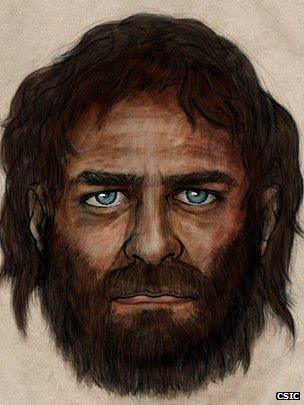Hunter-gatherer European had blue eyes and dark skin
- Published

The team was surprised by the hunter gatherer's unusual colouring
Scientists have shed light on what ancient Europeans looked like.
Genetic tests reveal that a hunter-gatherer who lived 7,000 years ago had the unusual combination of dark skin and hair and blue eyes.
It has surprised scientists, who thought that the early inhabitants of Europe were fair.
The research, led by the Institute of Evolutionary Biology in Barcelona, Spain, is published in the journal Nature, external.
The lead author, Dr Carles Lalueza-Fox, said: "One explanation is that the lighter skin colour evolved much later than was previously assumed."
Scandinavian links
Two hunter-gatherer skeletons were discovered in a cave in the mountains of north-west Spain in 2006.
The cool, dark conditions meant the remains (called La Brana 1 and 2) were remarkably well preserved. Scientists were able to extract DNA from a tooth of one of the ancient men and sequence his genome.
The team found that the early European was most closely genetically related to people in Sweden and Finland.
But while his eyes were blue, his genes reveal that his hair was black or brown and his skin was dark.
"This was a result that was unexpected," said Dr Lalueza-Fox.
Scientists had thought the first Europeans became fair soon after they left Africa and moved to the continent about 45,000 years ago.
"It has been assumed that it is something that happens in response to going from Africa to higher latitudes where the UV radiation is very low and you need to synthesise vitamin D in your skin. Your skin becomes lighter quite soon," explained Dr Lalueza-Fox.
"It is obvious that this is not the case, because this guy has been in Europe for 40,000 years and he still has dark skin."
The bones of the 7,000-year-old man were discovered in a cave in Spain
The hunter-gatherer's genome also gave the team an insight into how humans had changed as they moved from foraging to farming.
The early European would have subsisted on a diet of mainly protein, and his DNA reveals that he was lactose-intolerant and unable to digest starch. The ability to ingest dairy projects and starchy foods came after agriculture was adopted and people changed what they ate.
Commenting on the research, David Reich, from Harvard Medical School in the US, said: "The significance of this paper is that it reports the oldest European genome sequence reported to date - the first European genome sequence that predates the appearance of agriculture.
"The dark skin is a very interesting finding, as light skin is nearly universal across Europe today. These results suggest that the light skin seen across Europe today is a development of the last at least 7,000 years."
He added: "It will be very interesting to see how general this result is across ancient pre-agricultural Europe once additional genome sequences become available."
Early results of research that Prof Reich has been involved with were recently published on the biology preprint website bioRxiv.org, external and a paper has been submitted to a journal.
He has looked at the genomes of several hunter-gatherers and early farmers in Europe. This work suggests that present-day Europeans derive from three ancient populations of early inhabitants of the continent.
Follow Rebecca on Twitter, external
- Published20 November 2013
- Published10 October 2013
- Published23 April 2013
- Published18 December 2013
- Published27 April 2012
- Published20 December 2013
- Published22 December 2010
